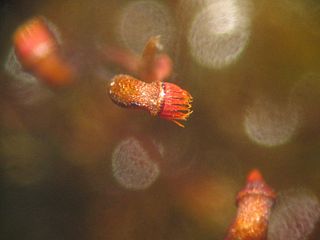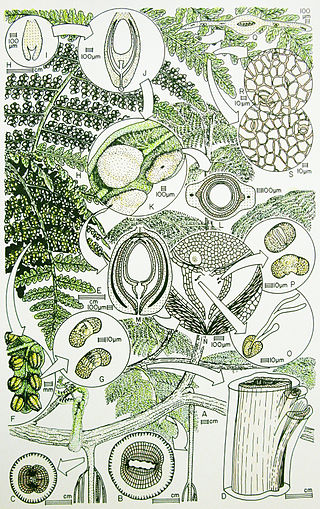
Chlorophyta is a taxon of green algae informally called chlorophytes. The name is used in two very different senses, so care is needed to determine the use by a particular author. In older classification systems, it is a highly paraphyletic group of all the green algae within the green plants (Viridiplantae) and thus includes about 7,000 species of mostly aquatic photosynthetic eukaryotic organisms. In newer classifications, it is the sister clade of the streptophytes/charophytes. The clade Streptophyta consists of the Charophyta in which the Embryophyta emerged. In this latter sense the Chlorophyta includes only about 4,300 species. About 90% of all known species live in freshwater. Like the land plants, green algae contain chlorophyll a and chlorophyll b and store food as starch in their plastids.

The order Pinales in the division Pinophyta, class Pinopsida, comprises all the extant conifers. The distinguishing characteristic is the reproductive structure known as a cone produced by all Pinales. All of the extant conifers, such as Araucaria, cedar, celery-pine, cypress, fir, juniper, kauri, larch, pine, redwood, spruce, and yew, are included here. Some fossil conifers, however, belong to other distinct orders within the division Pinophyta.

Thallophytes are a polyphyletic group of non-motile organisms traditionally described as "thalloid plants", "relatively simple plants" or "lower plants". They form a division of kingdom Plantae that include lichens and algae and occasionally bryophytes, bacteria and slime moulds. Thallophytes have a hidden reproductive system and hence they are also incorporated into the similar Cryptogamae category, as opposed to Phanerogamae. Thallophytes are defined by having undifferentiated bodies, as opposed to cormophytes (Cormophyta) with roots and stems. Various groups of thallophytes are major contributors to marine ecosystems.

The embryophytes are a clade of plants, also known as Embryophyta or land plants. They are the most familiar group of photoautotrophs that make up the vegetation on Earth's dry lands and wetlands. Embryophytes have a common ancestor with green algae, having emerged within the Phragmoplastophyta clade of freshwater charophyte green algae as a sister taxon of Charophyceae, Coleochaetophyceae and Zygnematophyceae. Embryophytes consist of the bryophytes and the polysporangiophytes. Living embryophytes include hornworts, liverworts, mosses, lycophytes, ferns, gymnosperms and angiosperms. Embryophytes have diplobiontic life cycles.

Euteleostomi is a successful clade that includes more than 90% of the living species of vertebrates. Both its major subgroups are successful today: Actinopterygii includes most extant bony fish species, and Sarcopterygii includes the tetrapods.

Streptophyta, informally the streptophytes, is a clade of plants. The composition of the clade varies considerably between authors, but the definition employed here includes land plants and all green algae except the Chlorophyta and the more basal Prasinodermophyta.

Charophyta is a group of freshwater green algae, called charophytes, sometimes treated as a division, yet also as a superdivision or an unranked clade. The terrestrial plants, the Embryophyta emerged deep within Charophyta, possibly from terrestrial unicellular charophytes, with the class Zygnematophyceae as a sister group.

Pteridospermatophyta, also called "pteridosperms" or "seed ferns" are a polyphyletic grouping of extinct seed-producing plants. The earliest fossil evidence for plants of this type are the lyginopterids of late Devonian age. They flourished particularly during the Carboniferous and Permian periods. Pteridosperms declined during the Mesozoic Era and had mostly disappeared by the end of the Cretaceous Period, though Komlopteris seem to have survived into Eocene times, based on fossil finds in Tasmania.

Jungermanniopsida is the largest of three classes within the division Marchantiophyta (liverworts).

Viridiplantae constitute a clade of eukaryotic organisms that comprises approximately 450,000–500,000 species that play important roles in both terrestrial and aquatic ecosystems. They include the green algae, which are primarily aquatic, and the land plants (embryophytes), which emerged from within them. Green algae traditionally excludes the land plants, rendering them a paraphyletic group. However it is accurate to think of land plants as a kind of alga. Since the realization that the embryophytes emerged from within the green algae, some authors are starting to include them. They have cells with cellulose in their cell walls, and primary chloroplasts derived from endosymbiosis with cyanobacteria that contain chlorophylls a and b and lack phycobilins. Corroborating this, a basal phagotroph archaeplastida group has been found in the Rhodelphydia.

The Bryopsida constitute the largest class of mosses, containing 95% of all moss species. It consists of approximately 11,500 species, common throughout the whole world.
One of the prime systems of plant taxonomy, the Engler system was devised by Adolf Engler (1844–1930), and is featured in two major taxonomic texts he authored or co-authored. His influence is reflected in the use of the terms "Engler School" and "Engler Era". Engler's starting point was that of Eichler who had been the first to use phylogenetic principles, although Engler himself did not think that he was.

Trimerophytopsida is a class of early vascular plants from the Devonian, informally called trimerophytes. It contains genera such as Psilophyton. This group is probably paraphyletic, and is believed to be the ancestral group from which both the ferns and seed plants evolved. Different authors have treated the group at different taxonomic ranks using the names Trimerophyta, Trimerophytophyta, Trimerophytina, Trimerophytophytina and Trimerophytales.

The euphyllophytes are a clade of plants within the tracheophytes. The group may be treated as an unranked clade, a division under the name Euphyllophyta or a subdivision under the name Euphyllophytina. The euphyllophytes are characterized by the possession of true leaves ("megaphylls"), and comprise one of two major lineages of extant vascular plants. As shown in the cladogram below, the euphyllophytes have a sister relationship to the lycopodiophytes or lycopsids. Unlike the lycopodiophytes, which consist of relatively few presently living or extant taxa, the euphyllophytes comprise the vast majority of vascular plant lineages that have evolved since both groups shared a common ancestor more than 400 million years ago. The euphyllophytes consist of two lineages, the spermatophytes or seed plants such as flowering plants (angiosperms) and gymnosperms, and the Polypodiophytes or ferns, as well as a number of extinct fossil groups.

The Horneophytopsida, informally called horneophytes, are a class of extinct plants which consisted of branched stems without leaves, true roots or vascular tissue, found from the Late Silurian to the Early Devonian. They are the simplest known polysporangiophytes, i.e. plants with sporophytes bearing many spore-forming organs (sporangia) on branched stems. They were formerly classified among the rhyniophytes, but it was later found that some of the original members of the group had simple vascular tissue and others did not. The group has also been treated as the division Horneophyta.

A seed plant or spermatophyte, also known as a phanerogam or a phaenogam, is any plant that produces seeds. It is a category of embryophyte that includes most of the familiar land plants, including the flowering plants and the gymnosperms, but not ferns, mosses, or algae.

Callistophytales is an extinct order of spermatophytes which lived from the Pennsylvanian to Permian periods. They were mainly scrambling and lianescent (vine-like) plants found in the wetland "coal swamps" of Euramerica and Cathaysia. Like many other early spermatophytes, they could be described as "seed ferns", combining ovule-based reproduction with pinnate leaves superficially similar to modern ferns.
Lyginopteridaceae is an extinct family of plants (Pteridospermatophyta) in North America and European Carboniferous coal measures.

The Phragmoplastophyta are a proposed sister clade of the Klebsormidiaceae in the Streptophyte/Charophyte clade. The Phragmoplastophyta consist of the Charophycaea and another unnamed clade which contains the Coleochaetophyceae, Zygnematophyceae, Mesotaeniaceae, and Embryophytes. It is an important step in the emergence of land plants within the green algae. It is equivalent to the ZCC clade/grade, cladistically granting the Embryophyta.














